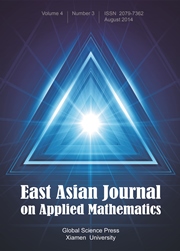No CrossRef data available.
Article contents
An Artificial Boundary Condition for a Class of Quasi-Newtonian Stokes Flows
Published online by Cambridge University Press: 28 May 2015
Abstract
An artificial boundary condition method, derived in terms of infinite Fourier series, is applied to solve a class of quasi-Newtonian Stokes flows. Based on the natural boundary reduction involving an artificial condition on the artificial boundary, the coupled variational problem and its numerical solution are obtained. The unique solvability of the continuous and discrete formulations are discussed, and the error analysis for the problem is also considered. Finally, an a posteriori error estimate for the corresponding problem is provided.
- Type
- Research Article
- Information
- Copyright
- Copyright © Global-Science Press 2014


